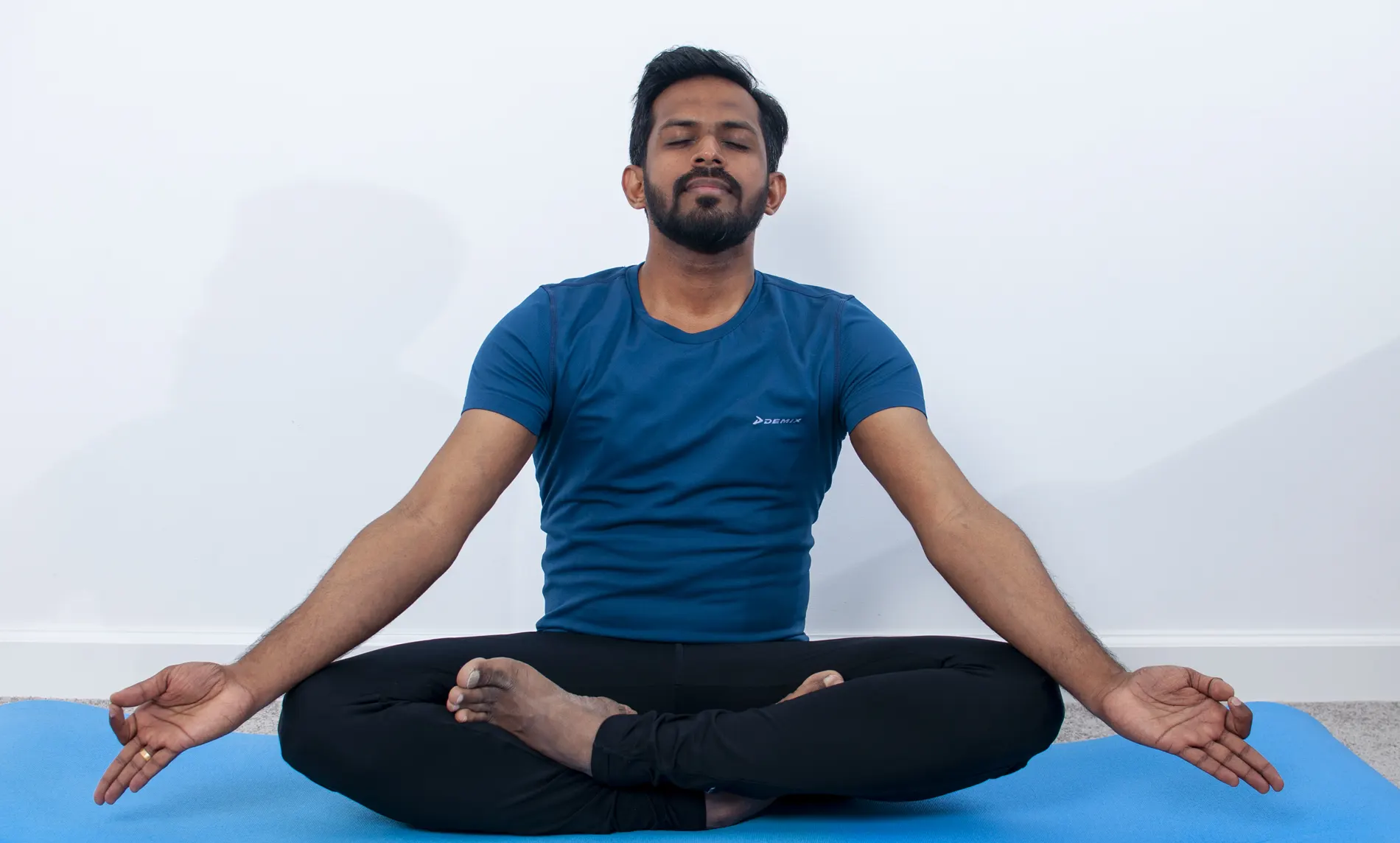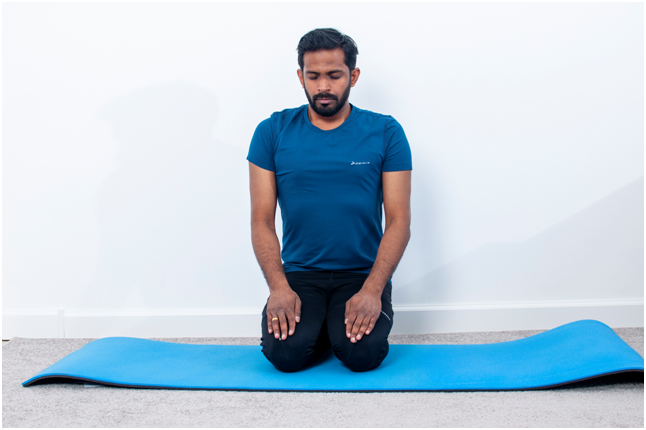Sarvam Meditation
- The unique and the best Ayurvedic mind balancing method

Sarvam method of Ayurvedic meditation is a method of finding ourself and keeping our mind balanced. Dr.Varun Ram Raj is called as the best Meditation specialist who is using the best Ayurvedic method of meditation called as Sarvam meditation. This is a method of meditation which can be done either under the direct guidance of Dr.Varun Ram Raj or by following the instructions given (without the direct guidance). This is one of the best method of meditation which helps to find out the right point of mis-balance and helps to heal it. Here in this method, the intellect, memory, courage, knowledge of the reality, breathing technique, concentration and focusing are used.
This is the Ayurvedic method used in the management of various psychic as well as psychosomatic conditions. Anxiety disorders, depression, stress, eating disorders, tension, addictions, breathing disorders like asthma, apathy, fear, lack of confidence, lack of concentration, bowel disorders, muscle tension, certain nervous system related conditions etc. can be well managed with this method of Ayurvedic meditation and mind balancing practised under the guidance of doctor Varun Ram Raj.
This helps to identify and solve the problems of our mind by using the principles of Ayurveda. Ayurveda have proved that the body and mind are interconnected and the method of Sarvam meditation helps in balancing the mind and thus balancing the body.
In Ayurveda there is a method of mind balancing and healing, which is called as Satvavajaya chikitsa. The Sarvam method of Ayurvedic mind balance uses, Sattvavajya chikitsa as the basic principle. Here in this method, the doshas of mind namely Rajas and Tamas are balanced.
Satvavajaya method of treatment is one of the fundamental method among 3 types of treatment in Ayurveda, the other methods areDaivyapashraya and Yuktivyapashraya. Satvavajya method is meant exclusively for the ‘manas’ or the mind and its related attributes. The term 'Satvavajaya' is made up of 2 parts and can be understood by knowing the meaning of these 2 parts,
Satva
The term “Sattva” has been used to refer 2 different things in Ayurveda. Sattva is one of the trigunas, that refer to the qualities of mind namely Sattva, Rajas and Tamas. And also, Satva means manas or mind.
Avajaya
The term “Avajaya” means to withdraw or to overcome
In total, Satvavajaya method of treatment means, to withdraw the mind from unwholesome objects or to overcome the various difficulties of mind. It gives importance in the achievement of balance between sattva, rajas and tamas that are the three controlling factors of the mind. It also works with an objective to increase the satva guna (the quality of mind which keeps it clean) by diminishing the other two doshas of mind. The three factors namely Sattva, Rajas and Tamas should be in a state of balance for maintaining a healthy mind. Sattva guna increasing keeps an individual away from wide range of mind related mis-balances. In certain health conditions of mind Ayurveda supports the increase of Rajas guna (in the the case of inactivity or lack of energy) and in certain conditions Ayurveda supports increase of tamas guna also (in the condition of sleeplessness increase of tamas is required for retaining a good sleep). In comparison with modern sciences, Satvavajaya chikitsa is almost equivalent to cognitive behaviour therapy and psychotherapy to some extent as this methods share a lot of factors in common.Thus the method of Sattvajaya that restraints the mind from desires for unwholesome objects by increasing the sattva gunas (good quality of the mind) is known as the Satvavajaya chikitsa, which is the basic principle used in the “Sarvam meditation”.
Sattva quality is the light for the mind. The ‘light” refers to the knowledge that help one to know the true and ultimate nature of anything in this world. This knowledge is used to lead the mind through a balanced path.
Mind is considered as the connecting link between soul and sense organs. Mind influences sense organs and initiate them in their various activities. Therefore mind also has potential to control these sense organs as well as organs of action and restrain them from their action, especially which are not required for the balance of the doshas. Along with that, mind itself performs few actions independently and those are called as karmas of mind or functions of mind. The functions of mind are described as,
- Controlling sense organs as well as organs of action
- Controlling mind itself
- Analysing
- Thinking / decision / understanding
It is clear from above actions of mind, it has the potential to generate and even control any action, thought, emotions. Therefore when any of these components are responsible for causing any illnesses or mis-balances, “Sarvam meditation” or the mind balancing becomes an unavoidable part of treatment along with other aspects.
As there are doshas of the body namely Vata, Pitta and kapha, there are also doshas of mind which are rajas and tamas. Attaining a balance between rajas, tamas and sattva (the three qualities of mind) is the target of Satvavajaya method and Sarvam method of meditation. Various methods that can help to achieve this balance and specifically increase the sattva quality of mind are employed in this method. Sattva quality is path of cleanliness and purity, Rajas is the path of activeness and competition, Tamas is the path of slowness and laziness. All these qualities must be in a balance for maintaining a healthy mind. Increasing the sattva quality to an unlimited level can be done by any individual. Extreme increase or decrease of rajas and tamas may impair the stability of the mind. Various practices including learning the basic principles of life based on Ayurveda/ aim of life, pillars of life, sub-pillars of life, learning of life and it’s origin, various rules of life and conducts, relaxation techniques, breathing techniques etc. are the essential part of Sarvam method Ayurvedic meditation. The key part of Sarvam meditation is to learn about oneself, understand the mis-balances, determining the remedies and practising it. There are generally two methods practised in Sarvam meditation, they are “guided by the guide” as well as “self-guided” (based on the instructions given in advance). The guided variant is performed under the online or direct presence of Dr.Varun Ram Raj.
The method starts, with recording the events of as guided by Dr.Varun and the followed by performing controlled breathing, concentration and focussing. The right point of mis-balance is found out and this is removed with help of understanding the reality, using knowledge and courage. This method gives high success rates in the management of various psychic as well as psycho-somatic conditions. Anxiety disorders, depression, stress, eating disorders, tension, addictions, breathing disorders like asthma, apathy, fear, lack of confidence, lack of concentration, bowel disorders, muscle tension, certain nervous system related conditions etc. can be well managed with this method of Ayurvedic meditation practised under the guidance of doctor Varun Ram Raj.
Mind balancing is the major aim of Sarvam method of meditation. The balance of these three qualities (Sattva, Rajas and Tamas) can be attained through
- True Knowledge (Jnananam)
- Learning (Vijnanam) - general learning as well as learning about one self. Jnanam and Vijnanam are part of Buddhi (intelligence)
- Courage (Dhairyam)
- Memory (Smriti)- this can be used to identify the time of mis-balance occurred to the mind and can be used nullify the effect caused by that impact by the application of true knowledge.
These methods convey the idea of basic principles of Satvaavajaya chikitsa. Various methods of psychotherapy and cognitive behaviour therapy along with these methods can be employed in Satvavajaya chikitsa to achieve these objectives and get cure from disturbing health issues of body and mind through Sarvam Ayurvedic meditation.
The Satvavajaya method is used in the management of bodily disorders also, for example,The great Ayurveda school, Charaka samhita have explained that, in the cases of the initial stages of fever, one must avoid anger, for the easy recovery from the vitiation of doshas. In a similar manner inducing happiness and providing assurance are mentioned as other treatment aspects in the management of debility caused due to a certain pathology. Also in cellulitis, Ayurveda suggests to avoid the situation which can generate angeralong with other lifestyle modulation like unnecessary competitions, arguments etc. All these examples states the usage of Satvajaya method which is considered as the basic principle of Ayurvedic meditation namely “Sarvam” can be used also in the management of psychosomatic conditions too.
Ayurveda believes that, Raga (desire), Dvesham (hatred), Lobham (losing), Moham (confusion), madam (intoxication) and matsaryam (unnecessary competition) are the six major actions or deviations of mind which can bring the mis-balance. The aim of Sarvam method of meditation is to find the right point in our life where the mis-balance have happened and to find which among the above 6 factors have brought this mis-balance. Also following a virtuous path as well as training the mind to interact by maintaining a clear balance is the key concepts used in the Sarvam method of Ayurvedic meditation.
In Sarvam method of Ayurvedic meditation, after proper assessment, the mind is brought back to the state of balance through a reality check. Ayurveda believes the mis-balances of mind can be balanced by understanding the reality.
For example people worry for reason that ‘oh. I don’t have anyone to help”. The true fact is nobody has anyone help. We have to help ourselves by creating the situation. In a similar manner in the situations like “worrying about losing, worrying about not getting selected” , we can use the Sarvam method of meditation and make our minds balanced.
This is the only meditation which gives importance to the diet and regimen of individual. During the practice of “Sarvam” meditation there will be an individual diet and regimen plan, which will be based on three doshas and the levels of Sattva, Rajas and Tamas in an individual.
Sarvam method of mind balancing is a method which helps to balance the mind through understanding the reality, identifying the right point where the mis-balance took place and overcoming it through knowledge, proper remedies and courage with giving high accent on meditation.



